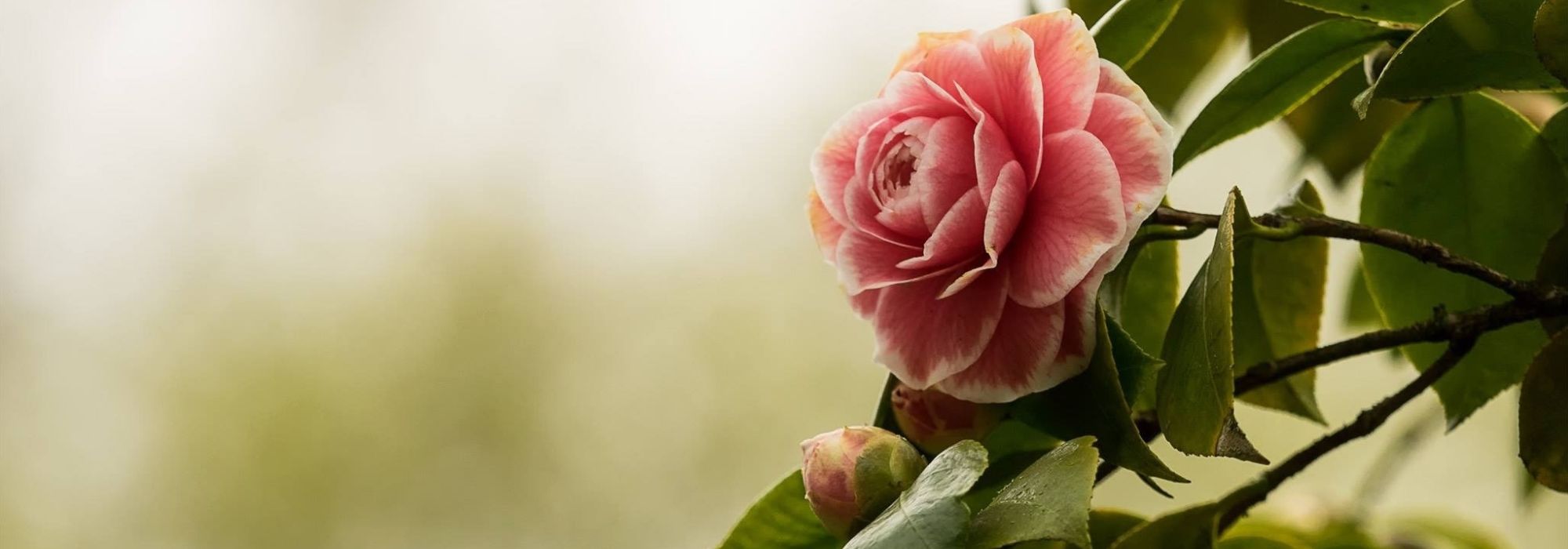
How best to combine camellias?
9 beautiful associations
Contents
Camellias are flowering shrubs suited to acidic soil. Native to forests of Asia, they are hardy and prefer shade or partial shade. They flower in winter, early spring or autumn depending on species. Evergreen and easy to grow, they harmonise easily in the garden with other bushes or flowering perennials. They reach between 1 and 3 metres and can be grown in pots, as a hedge or in borders. Let’s discover together which plants to pair with camellias in the garden!
For a flowering border in winter and early spring
Camellias that flower in winter and early spring can be paired with other perennials or winter-flowering bushes. This flowerbed brightens your garden at a time of year when flowering is scarce. Positioned on your daily path home or visible from your warm lounge, it will surely brighten your day.
To create a winter flowerbed, place early-season bulbs such as white narcissi in the foreground. The Narcissus triandrus ‘Thalia’ is a reliable classic for its single, airy and scented flowers. Accompany bulbs with hellebores, which flower effortlessly in shade, from white to red. The Helleborus orientalis ‘Aubergine’, which flowers deep red, and the white Helleborus orientalis complement camellias’ flowering perfectly. Add to the bed small shrubs such as Sarcococca ‘Winter Gem’, with white and pink flowers, or the highly fragrant Daphne mezereum var. rubra, with purplish-pink flowers. These tolerate acidic soil well.
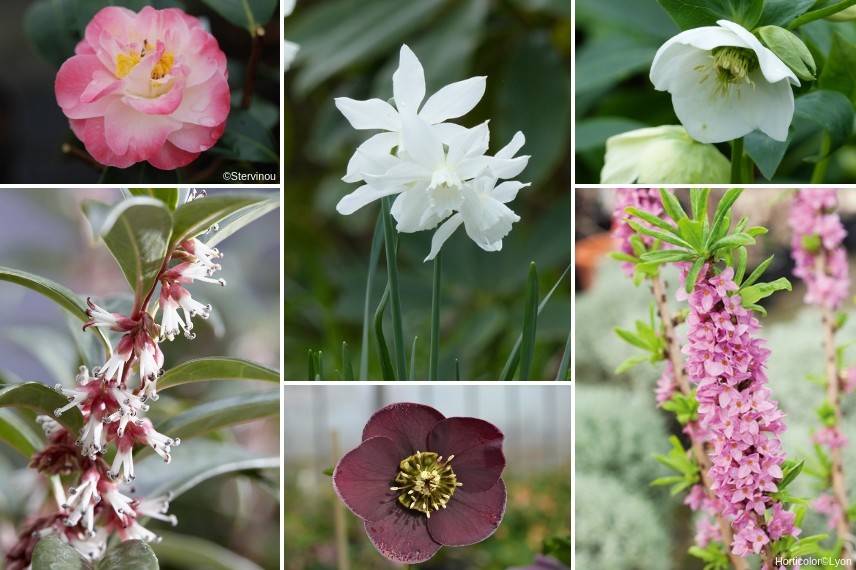
An example of an association for winter or early spring: Camellia ‘Spring Daze’, Narcissus ‘Thalia’, white Helleborus orientalis, Sarcococca ‘Winter Gem’, Helleborus orientalis ‘Aubergine’, Daphne mezereum var. rubra
If you wish to complement your winter flowerbed with larger-growing bushes, we recommend witch hazels for their delicate, clustered flowering. Hamamelis ‘Arnold Promise’, with yellow flowers, pairs wonderfully with the white flowers marked with yellow of Camellia ‘Jury’s Yellow’.
For an autumn-flowering border
With autumn camellias, create a flowerbed planted exclusively with autumn perennials. To achieve this, camellias are accompanied by perennials such as asters or by bulbs such as Nerines. Nerine ‘Isobel’, with its vivid pink flowering, tolerates acidic soils perfectly and harmonises with the white autumn camellia Early Pearly. The autumn display is completed by the essential colchicums flowering a delicate pink, and by Cyclamen of Naples, which tolerate acidic soils and partial shade to full shade.
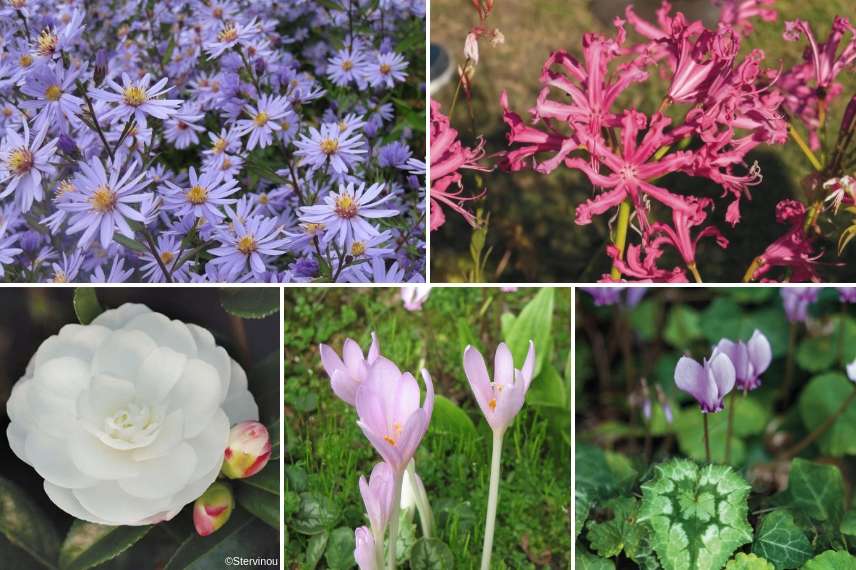
An example of an autumn combination: Aster cordifolius ‘Blue Heaven’, Nerine ‘Isobel’, Camellia ‘Early Pearly’, Colchicum autumnale ‘Major’, Cyclamen hederifolium
Discover other Camellia
View all →Available in 0 sizes
Available in 1 sizes
Available in 1 sizes
Available in 1 sizes

Available in 1 sizes
Available in 1 sizes
Available in 1 sizes
Available in 1 sizes
Available in 1 sizes
Available in 1 sizes
For Japanese-inspired ambience
Originating from Asia, camellias are indispensable in a Japanese garden. They can be combined to create a Japanese-inspired garden. To achieve this, pair them with large trees that also prefer acidic to neutral soils. You will find magnificent spring-flowering magnolias such as Magnolia stellata, Magnolia × soulangeana or Magnolia kobus. Also consider Japanese cherry or Japanese maples. To complete your Japanese-style garden, plant other bushes such as azaleas and rhododendrons. Add small ferns with a Japanese feel such as Cyrtomium falcatum or even Japanese anemones that flower later and in the shade of camellias. For this, Anemone ‘Margarete’ offers double flowers in an intense pink that complements the softer pink of camellias such as Camellia japonica ‘Virginia Robinson’.
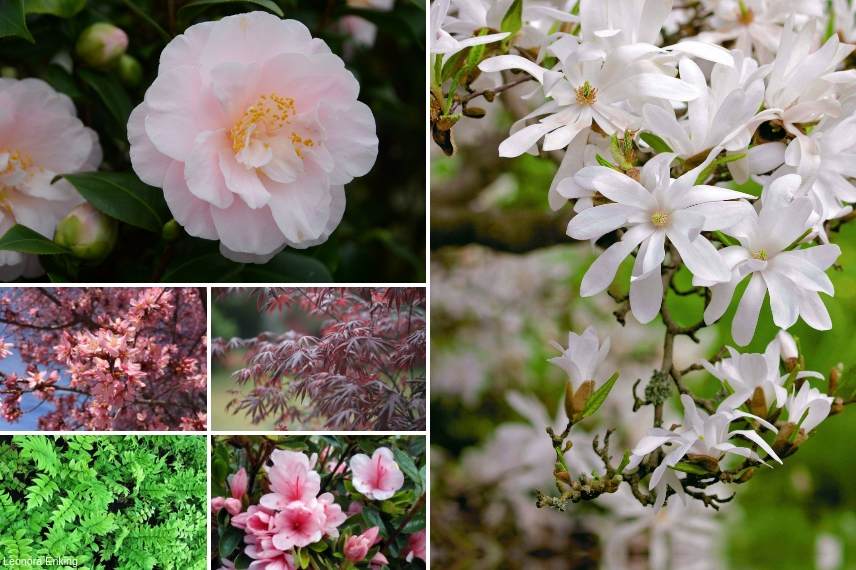
An example of an association in a Japanese-style setting: Camellia japonica ‘Virginia Robinson’, Prunus ‘Okame’, Acer palmatum ‘Trompenburgh’, Cyrtomium falcatum, Japanese azalea ‘Kirin’ and Magnolia stellata
Read also
7 essential camelliasFor woodland ambience
Camellias generally prefer partial shade or shade. At their base, in shade, it is possible to create an understorey atmosphere by pairing them with wood hyacinths with delicate spring flowering and Asian lilies ‘Soft Music’ with fragrant white summer flowering. The atmosphere is completed with Cyclamen coum, which tolerate acidic soils and form a pleasant pink flowering tapetum from February to April. For a dense understorey, brunneras form a decorative groundcover with blue or white flowering in mid-spring.
To ensure your understorey persists even through winter, we recommend evergreen ferns such as the fern Asplenium scolopendrium, charming with its entire leaves arranged in clusters.
To provide shade for your camellias, choose larger trees such as beech, oak or conifers.
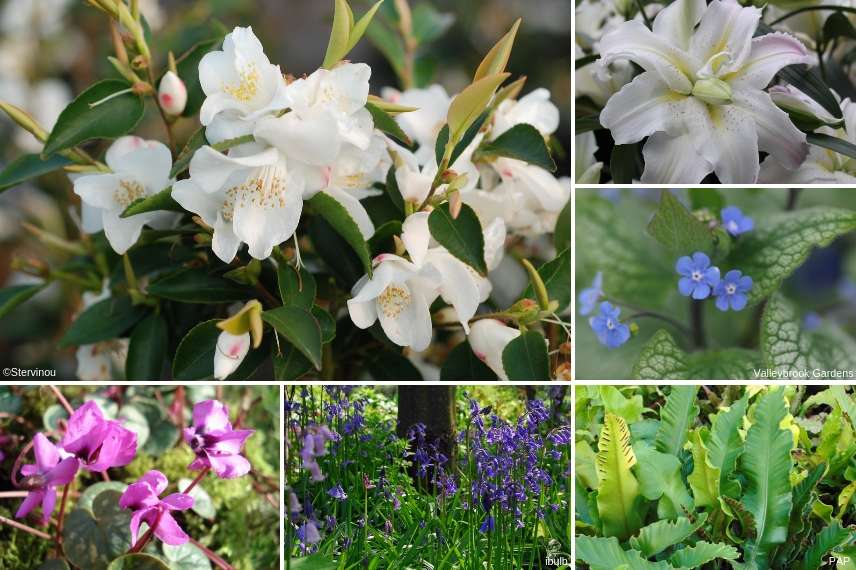
An example of understorey planting: Camellia transnokoensis, Lilium ‘Soft Music’, Brunnera macrophylla ‘Alexander’s Great’, Phyllitis scolopendrium, Scilla nutans, Cyclamen coum pink
For a bed of shrubs in acidic soil
Camellias go well with other bushes suited to acidic soil that can flower at the same time, such as pieris, or flower at different times. In summer, you will find a great diversity of hydrangeas whose colour will be blue or purple in acidic soil, heathers, the majestic flowering dogwoods or even the more modest shrubby veronica Quicksilver, ideal on the edge of a border.
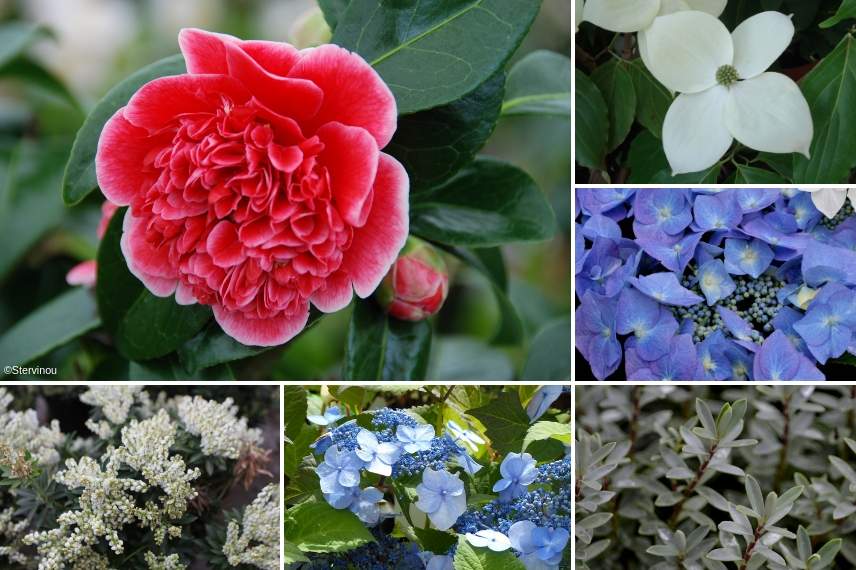
An example of an association in heather soil: Camellia ‘Volunteer’, Cornus ‘Eddie’s White Wonder’, Hydrangea macrophylla ‘Blaumeise’, Hebe pimeleoides ‘Quicksilver’, Hydrangea macrophylla ‘Twist and Shout’, Pieris japonica ‘Debutante’
Have you thought about planting a bed solely of camellias? Camellias pair easily with each other by playing with heights: the smallest at the front such as Camellia ‘Bonanza’, which reaches 1 metre high after 10 years. Then place taller camellias such as Camellia grijsii, which can reach 2.5 metres high. For colours, combine them within the same colour palette, use white as a link to harmonise tones, or simply choose camellias with staggered flowering times.
For a palette of pinks
Camellias generally flower in white, pink or red, with all intermediate shades. It is therefore possible to coordinate your camellias with flowering perennials and bushes of the same colour. Pink being the dominant colour in camellias, they pair well with strongly pink flowering perennials such as the pink bleeding heart, the pink trumpet lily, fuchsias or even hardy geraniums such as hardy geranium ‘Sirak’ with candy-pink flowers. Other bushes show pink tones such as Japanese quince or astilbes with airy, flowing summer flowers.
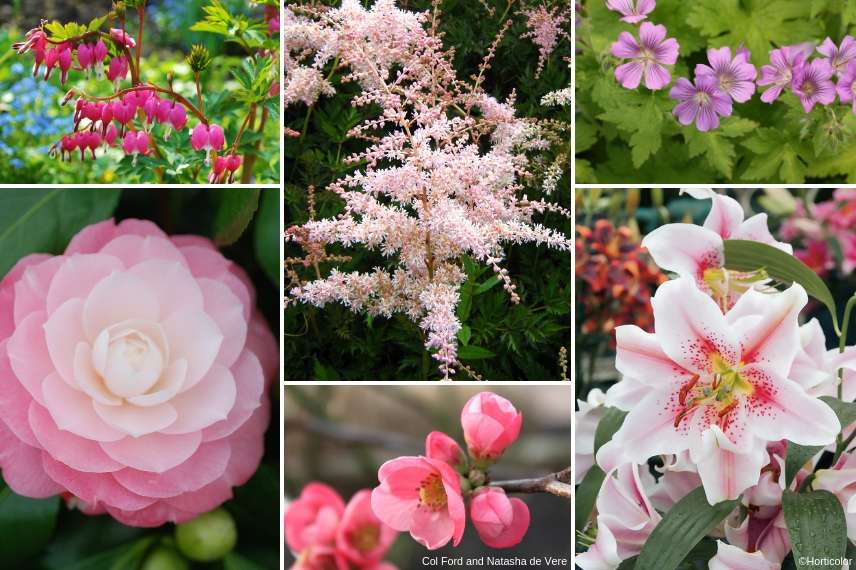
An example of a rose-toned monochrome combination: Dicentra spectabilis, Astilbe ‘Pink Lightning’, hardy geranium ‘Sirak’, Camellia japonica ‘Sweet Olive’, Chaenomeles x superba ‘Pink Lady’, Lilium ‘Mona Lisa’
For a carpet of plants at the base of your camellias
To showcase your camellias in open ground, choose a tapetum groundcover made of hostas or heucheras. Heuchera ‘Miracle’ delights with its light flowers and foliage that changes in autumn.
Choose an easy-care shade groundcover with barrenwort. They form a homogeneous tapetum at the foot of the camellia, making it even more pleasing to the eye. As for liriopes that flower in summer, they grow easily and provide a dense tapetum covering adventive plants. White periwinkle does the job just as well.
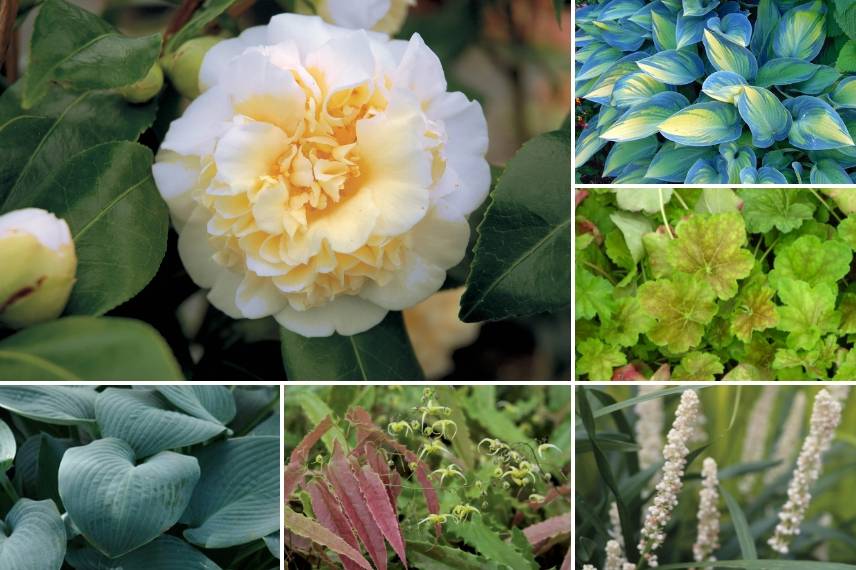
An example of a pairing with groundcover plants: Camellia ‘Jury’s Yellow’, Hosta ‘June’, Heuchera ‘Miracle’, Liriope muscari ‘Monroe White’, Epimedium ‘Sphinx Twinkler’, Hosta tardiana ‘Halcyon’
For a flowering hedge
Camellias are well suited to creating a flowering hedge. Complete your hedge with flowering bushes such as a Deutzia ‘Strawberry Fields’ or a mountain laurel with pale pink flowering. You can also include bushes bearing edible fruit. For semi-shaded corners where soil tends to be acidic, consider a quince tree, a strawberry tree, a serviceberry, a sweet cherry, a Morello cherry or even a Conference pear.

An example of a flowering hedge combination: Deutzia ‘Strawberry Fields’, Camellia ‘Adolphe Audusson’, Kalmia latifolia (pale pink)
For a terrace
Don’t have a garden? No problem — small-growing camellias are ideal for growing in pots. To grow a camellia in a pot, we recommend dwarf varieties such as Botanyuki, Fairy Wand and Sweet Emily Kate.
If your planter is large enough, they pair well with low-growing acid-loving plants such as summer heather, creeping wintergreen or sweet violet with fragrant flowering from March to June.
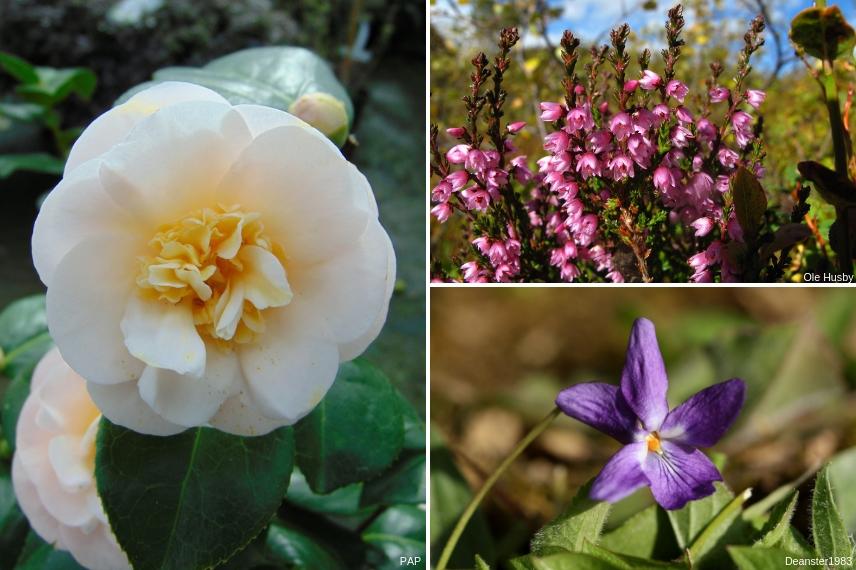
An example of a pot planting: Camellia ‘Botanyuki’, Calluna vulgaris ‘Marlies’, Viola odorata
Find out more
- Also discover 7 classic white camellias
- Subscribe!
- Contents
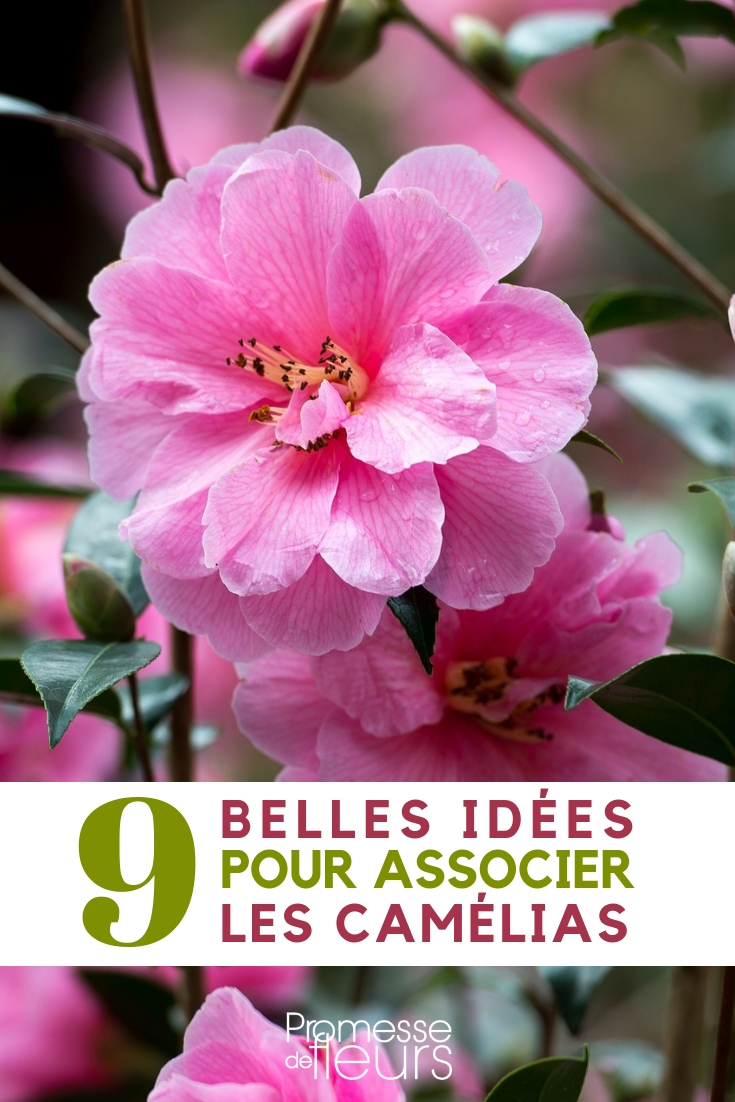































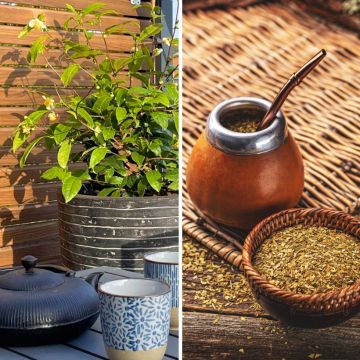
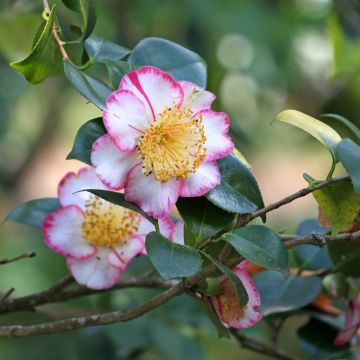
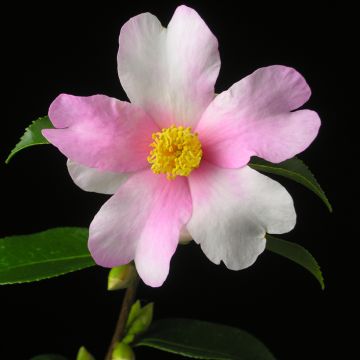

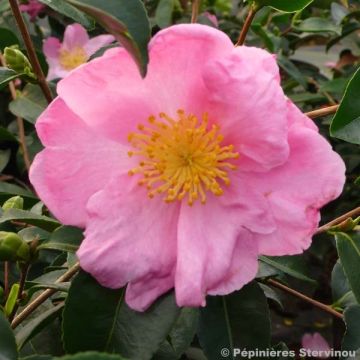
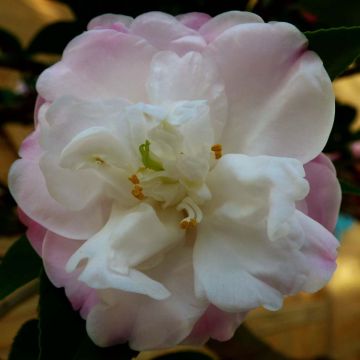
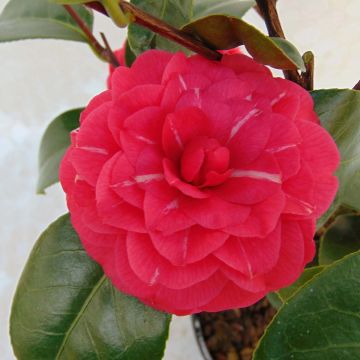
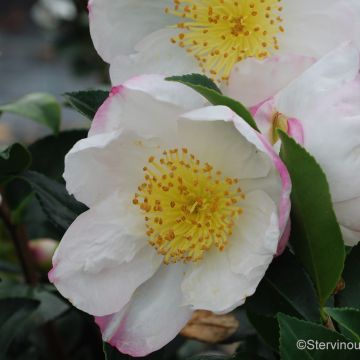
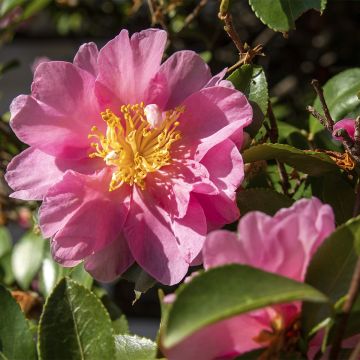
Comments